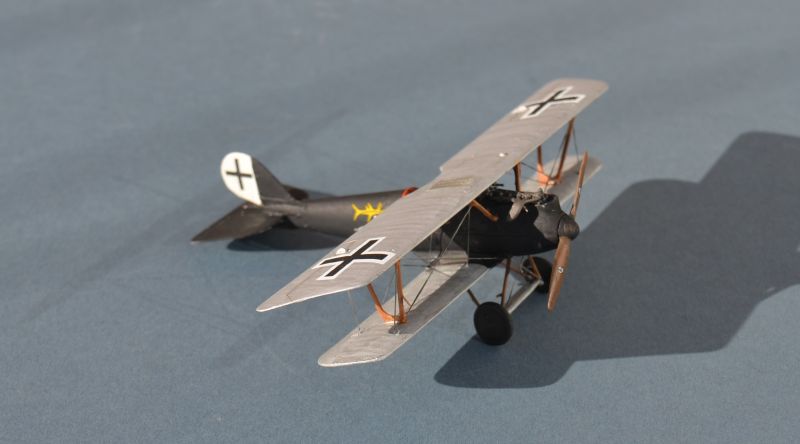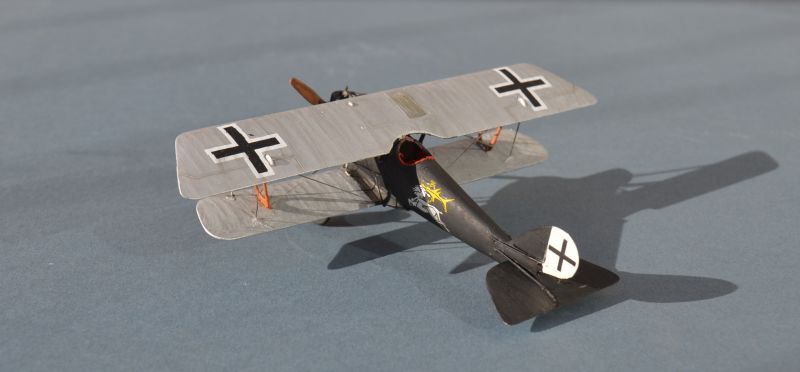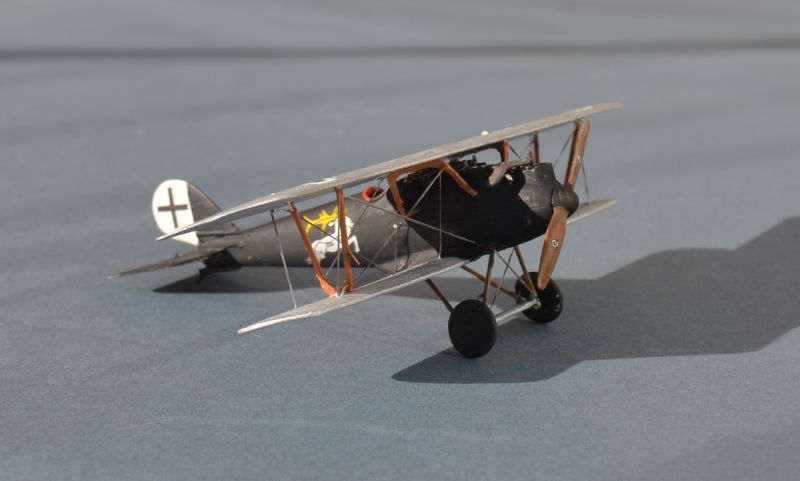De Havilland Venom FB.4
249 Sqn, RAF Akrotiri -
FROG 1/72
This month sees the first of 2 refurbishments of genuinely "classic" kits: The FROG De Havilland Venom FB.4 and the De Havilland DH.110, both kits that were first issued in 1955.
I acquired them at a Flea Market, for the princely sum of £1 each (yes really!).
They were both dirty, with the DH110 missing its undercarriage), but seemed to have
been built and painted to a reasonable standard, albeit with some rather rough seams
that would grate with any serious modern modeller -
Neither kit is stunningly accurate or detailed, so I intend to do a fairly simple refurb, albeit with some minor improvements.
The Venom is the rarer of the two, because the DH110 was reissued several times up to 1968 (when the moulds were alleged to have been lost in a shipwreck whilst on their way to Hong Kong from New Zealand), whilst the Venom was only issued once in the UK in 1955 and once in France in 1956, with the moulds being scrapped shortly after due to a defect.
Because of this rarity and since it represents an aircraft type that I don't yet have in my collection, I decided to start refurbishment with the Venom.
Refurbishing the FROG DH110 Venom FB.4 kit
For its time, the kit really looks quite good, with nicely thin wings and what 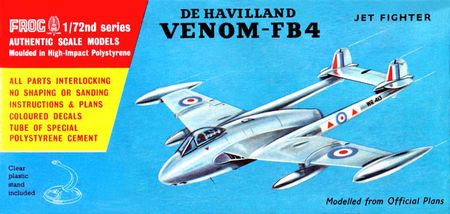 seems
to be a good shape (I can't be entirely sure of accuracy, but it certainly looks
good enough). Panel detail is raised, perhaps a bit heavily and it has some prominent
rivets that will need to come off. The undercarriage bays are marked out with panel
lines, but not open and the wheels/legs are very simple and crude so don't look underneath!
seems
to be a good shape (I can't be entirely sure of accuracy, but it certainly looks
good enough). Panel detail is raised, perhaps a bit heavily and it has some prominent
rivets that will need to come off. The undercarriage bays are marked out with panel
lines, but not open and the wheels/legs are very simple and crude so don't look underneath!
The cockpit, as was normal for kits of that era, is blanked with only a pilot's head and bit of an ejector seat moulded on top. The canopy came off cleanly, so this can be polished up, repainted and coated with Klear, whilst I can paint the (unpainted) pilot figure. Engine intakes are also blanked, with a simple representation of the intake vanes.
Judging by the overall weight of the kit, the provided weights (steel washers I think, but feel heavy enough to be lead) have been fitted in the provided moulded compartments inside the nose.
After-
Fortunately, I was able to prise the canopy off cleanly, allowing a quick internal
and external polish (using toothpaste) and an opportunity to paint the untouched
cockpit inside and pilot's head. The rest of the paint, the biggest rivets and most
of the decals were sanded off using fine wet & dry. The paint came off very easily,
so I'm not sure what type it was -
Fortunately, the special markings worn during the 1956 Suez operation included the removal of most squadron specific ones and my spares box could easily cover those serials and roundels that remained. I chose to do a 249 Sqn example as an extension of my Malta Air War project. Suez yellow and black stripes were masked out. Topside paint was Humbrol 163 (green) and 164 (dark sea grey), with 157 (azure blue) making a good substitute for the PRU blue undersides.
Left -
The end result is "good enough" and since this is a rare kit of an important RAF type, I feel that it was definitely worth restoring. For its age, it is also quite a good looking kit, with sufficient accuracy to meet my needs!
Link to many more WW1 German models on my “Other Side” Pages
My collection of WW1 German aircraft grows -
From top, clockwise: Roland C.II, Fokker D.VII, Pfalz D.IIIa, Albatros D.V
Jasta 40/Jasta 7, Luftstreitskrafte, Western Front, Summer 1918
Roden 1/72 with Xtradecal markings
Link to many more RAF models on my Friends and Allies pages
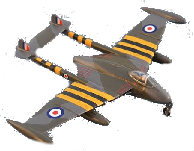
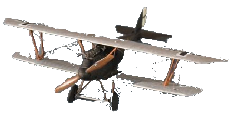
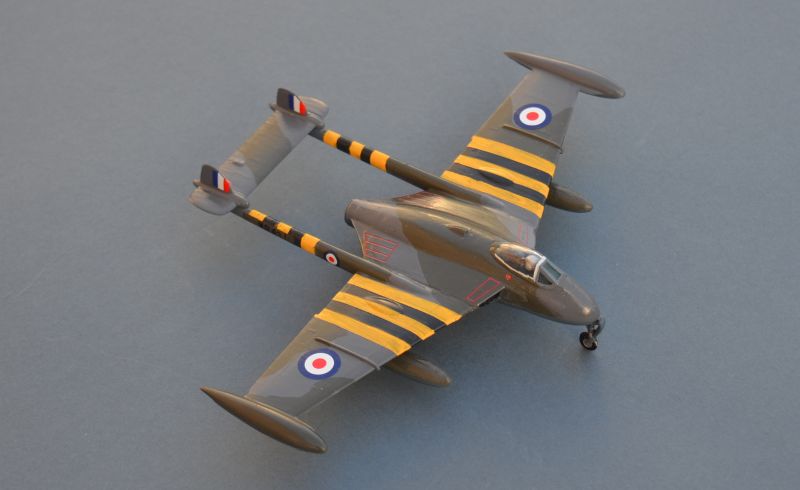
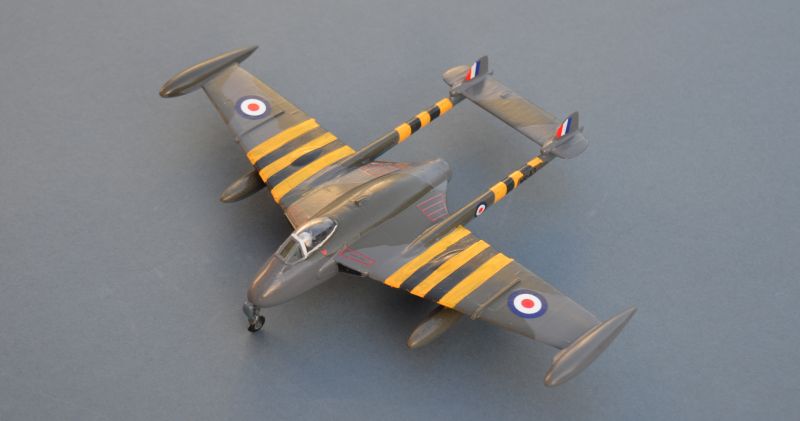



The De Havilland DH112 Venom was a fighter bomber development of the previous DH100 Vampire, fitted with a more powerful Ghost 103 turbojet and thinner wings with a leading edge sweep back. Wing tip fuel tanks helped to increase operating range.
Entering service in 1952, Venoms mainly operated abroad, with RAF squadrons based in Germany, the Mediterranean, Middle East, Africa and Far East. The Suez operation (Musketeer) in November 1956 saw the Venom operating at its peak; of all the RAF combat aircraft participating in the action, Venoms operating from RAF Akotiri in Cyprus saw the most effect and success. Only one Venom was lost, to Egyptian ground fire.
RAF Venoms left service in 1962, mostly to be replaced by Hunters. Export Venoms were also operated by the Iraqi, Italian, New Zealand, Swedish and Swiss air forces (the last right up until the 1980s).
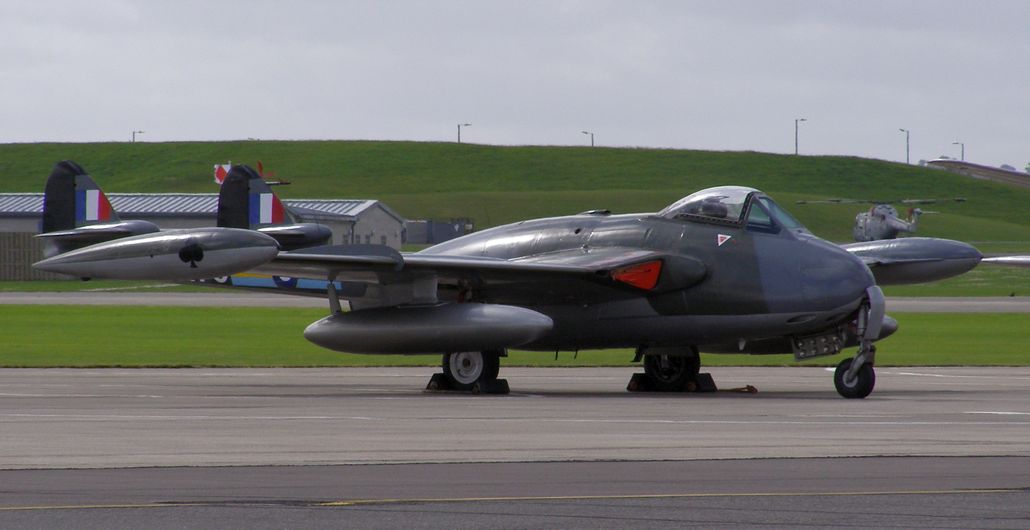
Marked as WR470, this is a restored ex-

My second buuild of the month was inspired by a “Biggles” book that I was reading, where the German pilot flew a Pfalz.
The Pfalz D.IIIa is a slightly less well known German fighter of WW1 compared with the Fokkers, Albatros' and Rolands. Built in Bavaria and mainly used by Bavarian Air Force units, its reputation may have suffered some discrimination as a result of the delicate political balance between catholic Bavaria and the mainly protestant rump of the German Empire.
Pfalz started in 1913 as a licence builder of Albatros aircraft along with Moraine Saulner monoplanes, but in late 1916 they launched their own design based on their experience.
It was never as capable as other contemporary designs, but had a high diving speed
and was structurally robust and reliable (i.e. it didn't lose its wings in a dive
like the Fokker and Albatros), so it found favour with some experienced pilots and
in specialised roles such as attacks on observation balloons. Early D.III versions
had their machine guns embedded in the fuselage which proved difficult to aim and
almost impossible to clear jammed guns; the D.IIIa variant moved these to the more
usual position in the pilots eye-
This model represents the aircraft of Hauptmann Carl Degelow, the CO of Royal Saxon Jagdstaffel 40 from July 1918 and one of the most decorated WW1 German pilots (Pour le Merite/Blue Max, Royal House Order of Hohenzollern, Iron Cross 1st & 2nd Class), who was credited with 30 victories, although the aircraft represented may date from his earlier time as a pilot in Jasta 7. He chose to fly the Pfalz over his allocated Albatros D.V because of issues with the Albatros' weak wing structure. He also flew a Fokker Dr.1 and a Fokker D.VII, the latter in which he scored most of his kills.
Following WW1, Degelow was an active supporter of anti communist militias, but was not an enthusiastic Nazi and was jailed at one point for failing to give a Nazi Salute, only being released when he was recognised as a highly decorated veteran. Although he served in WW2 as a Luftwaffe Major, his lack of political ambition and lukewarm attitude to Naziism prevented any further progression. He survived the war and died in Hamburg in 1970.

Building the Roden Pfalz D.IIIa kit
Ukrainian company Roden first issued this kit in 2000 as two separate boxings, an
early D.III and a D.IIIa. The sprues for both kits are identical. 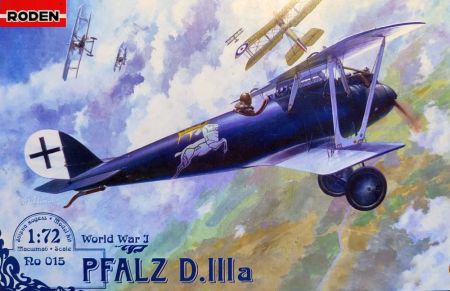
It is a very nicely moulded kit, suffering slightly from Roden's habit of making
parts too delicate and small to successfully remove from their sprues, but is by
no means their worst in this respect. As a result of this scale-
As a relatively early and conventional aircraft design, rigging is quite complex
and extensive -
Decals are neatly printed covering 3 interesting options, although there are some uncertainties over Roden's research and the colour of its wings and the stag emblem are open to discussion.
To my great relief none of the options uses Lozenge camouflage, although my copy
of the Profile pamphlet on the D.III does show that some aircraft did ! Sadly,
when it comes to application the decals failed me miserably (I was pre-
In summary, crumbly decals apart (coat them before you use them), this is a good small model, fiddly and delicate, but highly rewarding to build.
